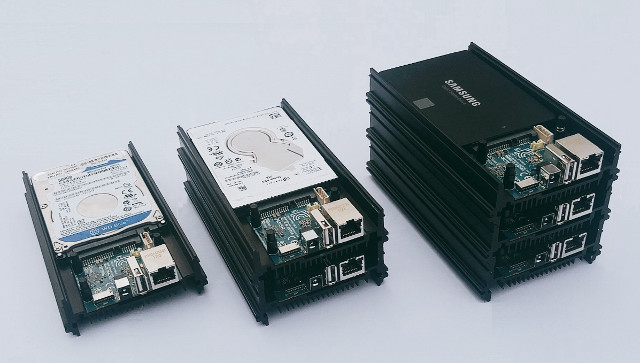Hardkernel has just launched their ODROID-HC1 stackable NAS system based on a cost-down version of ODROID-XU4 board powered by Samsung Exynos 5422 octa-core Cortex-A15/A7 processor, which as previously expect, you can purchase for $49 on Hardkernel website, or distributors like Ameridroid.
 We now have the complete specifications for ODROID-HC1 (Home Cloud One) platform:
We now have the complete specifications for ODROID-HC1 (Home Cloud One) platform:
- SoC – Samsung Exynos 5422 octa-core processor with 4x ARM Cortex-A15 @ 2.0 GHz, 4x ARM Cortex-A7 @ 1.4GHz, and Mali-T628 MP6 GPU supporting OpenGL ES 3.0 / 2.0 / 1.1 and OpenCL 1.1 Full profile
- System Memory – 2GB LPDDR3 RAM PoP @ 750 MHz
- Storage
- UHS-1 micro SD slot up to 128GB
- SATA interface via JMicron JMS578 USB 3.0 to SATA bridge chipset capable of achieving ~300 MB/s transfer rates
- The case supports 2.5″ drives between 7mm and 15mm thick
- Network Connectivity – 10/100/1000Mbps Ethernet (via USB 3.0)
- USB – 1x USB 2.0 port
- Debugging – Serial console header
- Misc – Power, status, and SATA LEDs;
- Power Supply
- 5V via 5.5/2.1mm power barrel (5V/4A power supply recommended)
- 12V unpopulated header (currently unused)
- Backup header for RTC battery
- Dimensions – 147 x85 x 29 mm (Aluminum case also serving as heatsink)
- weight – 229 grams
The company provides Ubuntu 16.04.2 with Linux 4.9, and OpenCL support for the board, the same image as ODROID-XU4, but there are also community supported Linux distributions including Debian, DietPi, Arch Liux ARM, OMV, Armbian, and others, which can all be found in the Wiki.

Based on Hardkernel’s own tests, you should be able to max out the Gigabit Ethernet bandwidth while transferring a files over SAMBA in either directions. tkaiser, an active member of Armbian, also got a sample, and reported that heat dissipation worked well, and that overall Hardkernel had a done a very good job.
While power consumption of the system is usually 5 to 10 Watts, it may jump to 20 Watts under heavy load with USB devices attached, so a 5V/4A power supply is recommended with the SATA drive only, and 5V/6A if you are also going to connect power hungry devices to the USB 2.0 port. The company plans to manufacture ODROID-HC1 for at least three years (until mid 2020), but expects to continue production long after, as long as parts are available.

Jean-Luc started CNX Software in 2010 as a part-time endeavor, before quitting his job as a software engineering manager, and starting to write daily news, and reviews full time later in 2011.
Support CNX Software! Donate via cryptocurrencies, become a Patron on Patreon, or purchase goods on Amazon or Aliexpress




